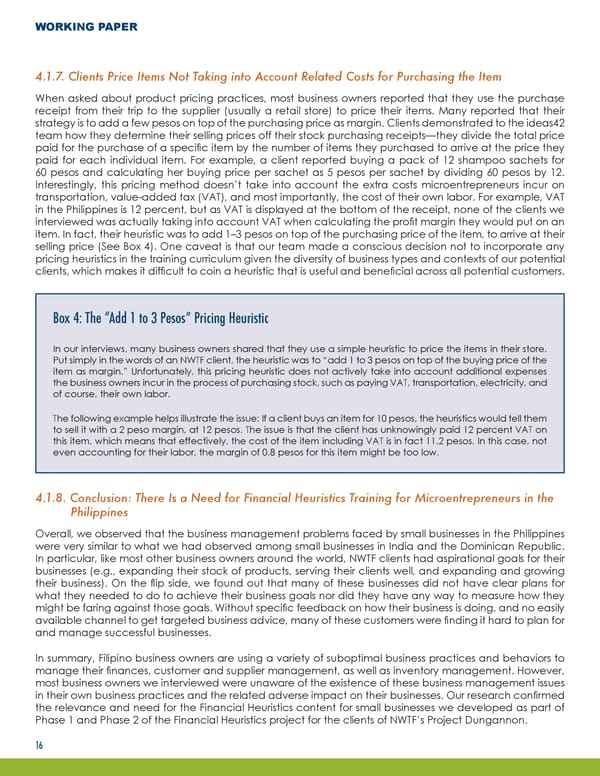WORKING PAPER 4.1.7. Clients Price Items Not Taking into Account Related Costs for Purchasing the Item When asked about product pricing practices, most business owners reported that they use the purchase receipt from their trip to the supplier (usually a retail store) to price their items. Many reported that their strategy is to add a few pesos on top of the purchasing price as margin. Clients demonstrated to the ideas42 team how they determine their selling prices off their stock purchasing receipts—they divide the total price paid for the purchase of a specific item by the number of items they purchased to arrive at the price they paid for each individual item. For example, a client reported buying a pack of 12 shampoo sachets for 60 pesos and calculating her buying price per sachet as 5 pesos per sachet by dividing 60 pesos by 12. Interestingly, this pricing method doesn’t take into account the extra costs microentrepreneurs incur on transportation, value-added tax (VAT), and most importantly, the cost of their own labor. For example, VAT in the Philippines is 12 percent, but as VAT is displayed at the bottom of the receipt, none of the clients we interviewed was actually taking into account VAT when calculating the profit margin they would put on an item. In fact, their heuristic was to add 1–3 pesos on top of the purchasing price of the item, to arrive at their selling price (See Box 4). One caveat is that our team made a conscious decision not to incorporate any pricing heuristics in the training curriculum given the diversity of business types and contexts of our potential clients, which makes it difficult to coin a heuristic that is useful and beneficial across all potential customers. Box 4: The “Add 1 to 3 Pesos” Pricing Heuristic In our interviews, many business owners shared that they use a simple heuristic to price the items in their store. Put simply in the words of an NWTF client, the heuristic was to “add 1 to 3 pesos on top of the buying price of the item as margin.” Unfortunately, this pricing heuristic does not actively take into account additional expenses the business owners incur in the process of purchasing stock, such as paying VAT, transportation, electricity, and of course, their own labor. The following example helps illustrate the issue: If a client buys an item for 10 pesos, the heuristics would tell them to sell it with a 2 peso margin, at 12 pesos. The issue is that the client has unknowingly paid 12 percent VAT on this item, which means that effectively, the cost of the item including VAT is in fact 11.2 pesos. In this case, not even accounting for their labor, the margin of 0.8 pesos for this item might be too low. 4.1.8. Conclusion: There Is a Need for Financial Heuristics Training for Microentrepreneurs in the Philippines Overall, we observed that the business management problems faced by small businesses in the Philippines were very similar to what we had observed among small businesses in India and the Dominican Republic. In particular, like most other business owners around the world, NWTF clients had aspirational goals for their businesses (e.g., expanding their stock of products, serving their clients well, and expanding and growing their business). On the flip side, we found out that many of these businesses did not have clear plans for what they needed to do to achieve their business goals nor did they have any way to measure how they might be faring against those goals. Without specific feedback on how their business is doing, and no easily available channel to get targeted business advice, many of these customers were finding it hard to plan for and manage successful businesses. In summary, Filipino business owners are using a variety of suboptimal business practices and behaviors to manage their finances, customer and supplier management, as well as inventory management. However, most business owners we interviewed were unaware of the existence of these business management issues in their own business practices and the related adverse impact on their businesses. Our research confirmed the relevance and need for the Financial Heuristics content for small businesses we developed as part of Phase 1 and Phase 2 of the Financial Heuristics project for the clients of NWTF’s Project Dungannon. 16
 Using Behavioral Science to Design a Customer-Centric Financial Management Training for Microentrepreneurs Page 18 Page 20
Using Behavioral Science to Design a Customer-Centric Financial Management Training for Microentrepreneurs Page 18 Page 20